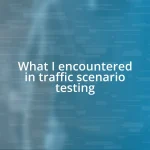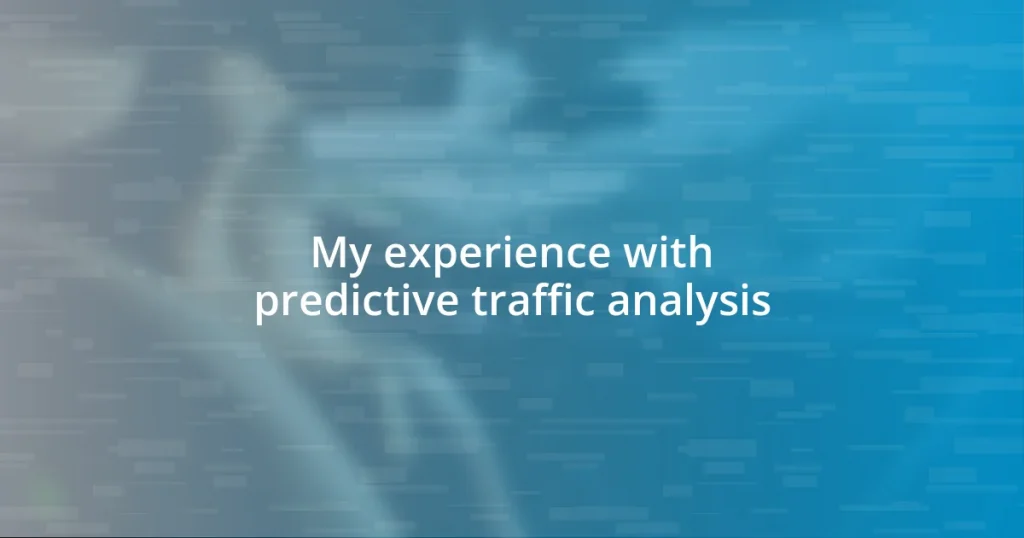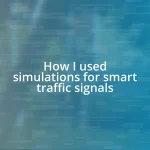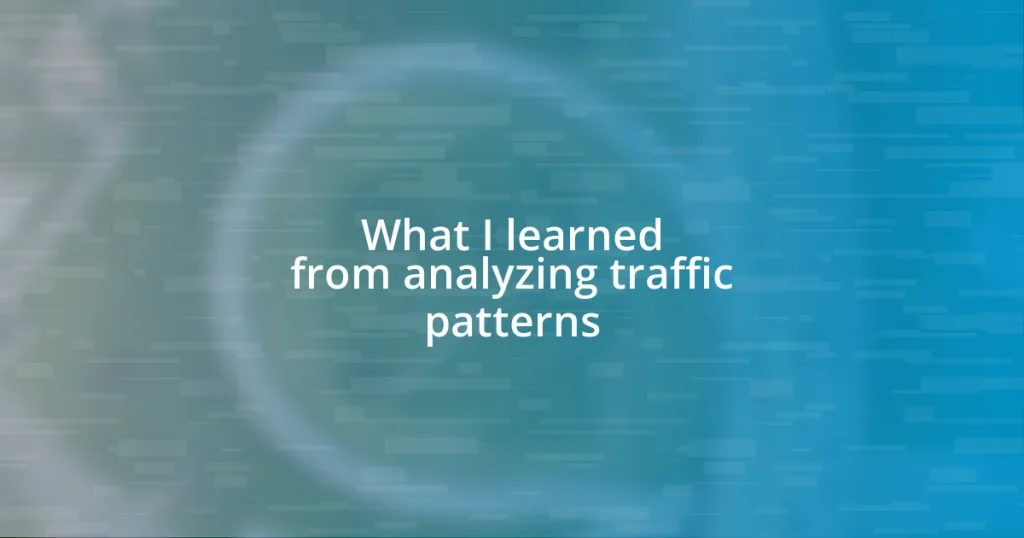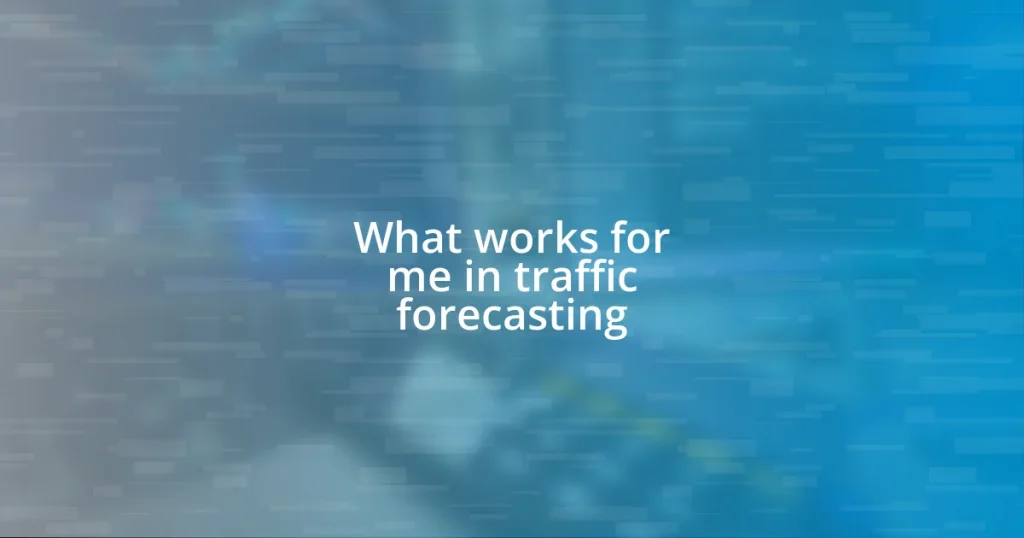Key takeaways:
- Predictive traffic analysis leverages historical and real-time data to improve driving experiences by anticipating traffic patterns and suggesting alternative routes.
- Effective traffic data analysis aids urban planning, reduces congestion, enhances safety, and empowers individuals with knowledge to optimize their daily commutes.
- While predictive models can significantly improve routing decisions, challenges such as unexpected disruptions and data quality must be addressed for reliable outcomes.
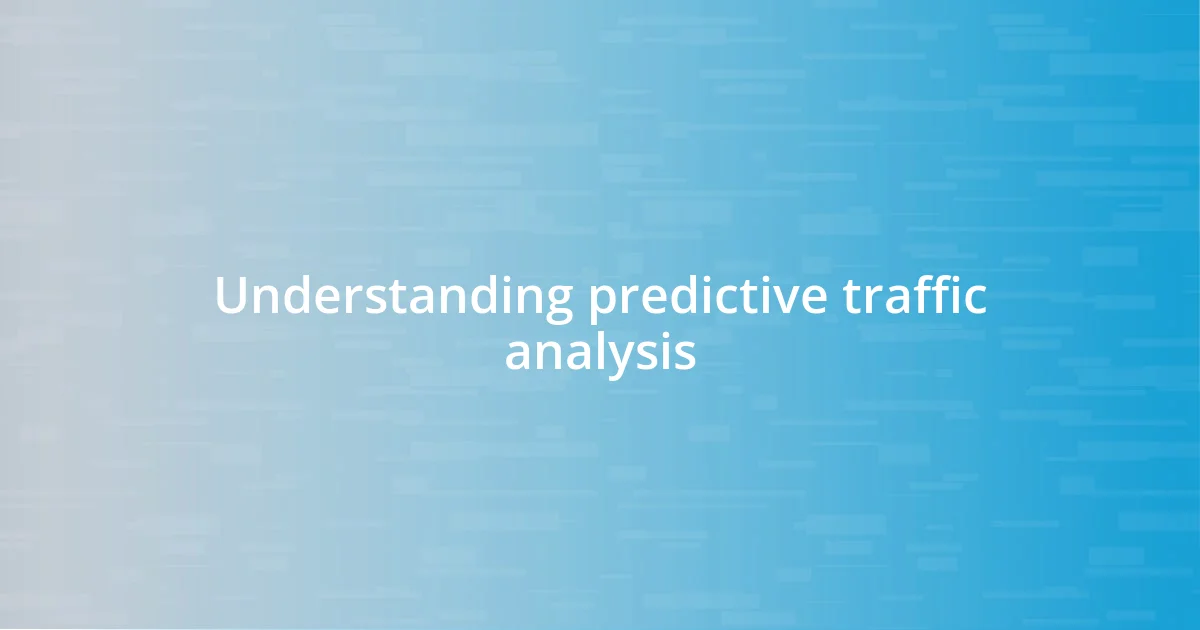
Understanding predictive traffic analysis
Predictive traffic analysis is fascinating because it combines technology with human behavior. When I first heard about it, I couldn’t help but wonder how algorithms could predict my daily routes. It’s like having a digital crystal ball that reveals what lies ahead on the road.
I remember a time when a predictive traffic app suggested an alternate route during rush hour. Skeptical yet intrigued, I decided to follow its guidance. To my surprise, I avoided a major jam, feeling a rush of exhilaration as I glided through less-congested streets. This experience highlighted how effective predictive traffic analysis can be in making real-time driving decisions.
At its core, predictive traffic analysis analyzes historical data to forecast future traffic patterns. Have you ever thought about how your driving habits might be influenced by this technology? I find it remarkable that this analysis can even consider factors such as weather conditions and local events, making it an invaluable tool for both urban planners and everyday commuters like myself.
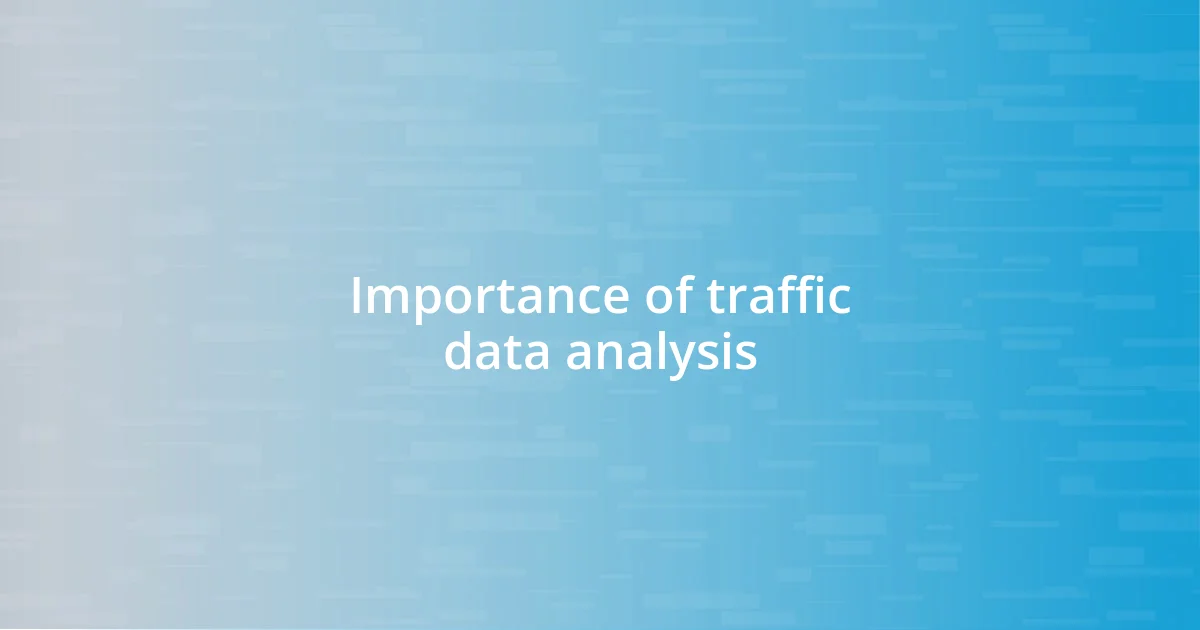
Importance of traffic data analysis
Traffic data analysis is crucial for understanding how road usage evolves over time. By examining traffic patterns, I’ve come to appreciate how this data can inform not just route planning, but also city development. When I drive through different neighborhoods, it’s interesting to connect the dots between the volume of cars and the growth of local businesses. Here’s what I believe makes traffic data analysis so important:
- It helps reduce congestion by identifying potential bottlenecks.
- It contributes to better urban planning through informed decision-making.
- It enhances safety by analyzing accident hotspots.
- It promotes environmental sustainability by optimizing traffic flow.
Moreover, I’ve seen firsthand how traffic data analysis can significantly impact my daily routine. There was a particularly frustrating week when I noticed delays on my usual commute route. After checking an analytics tool, I learned that a new development was causing unexpected traffic spikes. This insight allowed me to adjust my driving schedule, making it feel liberating to regain control over my time. It’s enlightening to know that traffic data analysis not only keeps roads more efficient but also enriches our daily experiences by empowering us with knowledge.
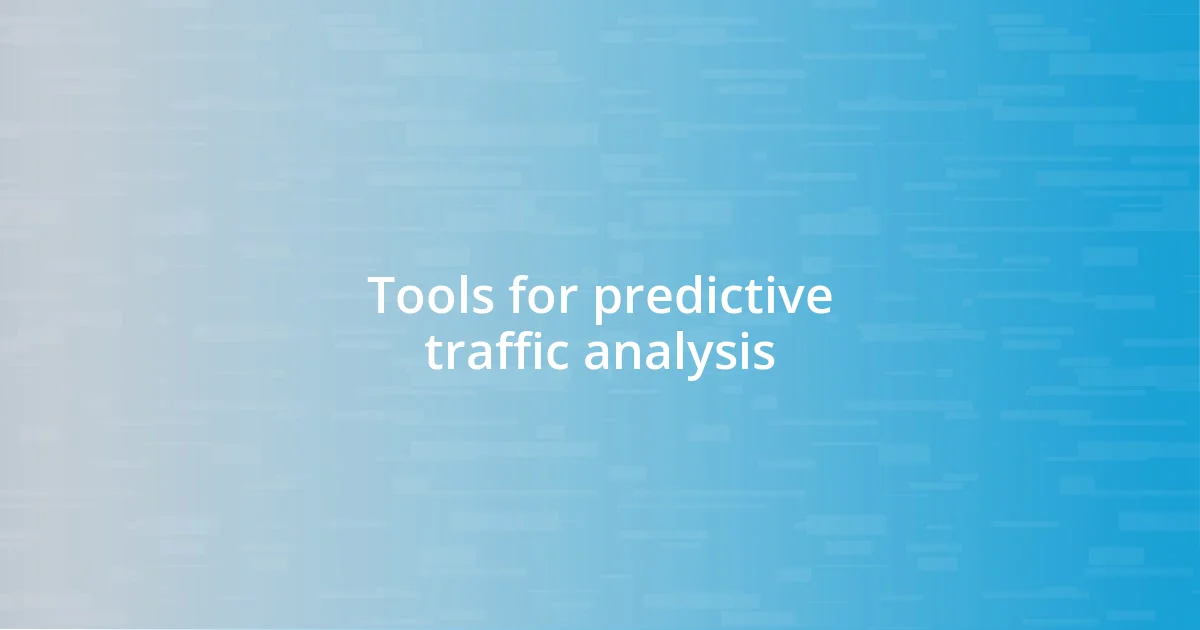
Tools for predictive traffic analysis
Tools for predictive traffic analysis come in various forms, each equipped with unique features that cater to different needs. I’ve experimented with some of these tools, and my experiences have been enlightening. For example, apps like Waze leverage crowdsourced data to inform users in real time about road conditions. I remember one evening when Waze guided me through a back road after a sudden accident on my route, turning a stressful commute into a surprisingly pleasant drive.
On the other hand, more complex platforms like Google Traffic not only analyze real-time data but also integrate historical patterns. This integration is impressive because it allows for a deeper understanding of traffic behaviors over time. The very first time I noticed how accurately Google Traffic projected travel times, it changed my approach to planning trips. I started considering not just the destination but also how time-sensitive my journey might be, allowing me to manage my schedule more effectively.
Lastly, for professionals in urban planning or logistics, tools like INRIX or IBM’s Intelligent Operations provide advanced analytics that help identify trends and optimize traffic flow. I was astounded by how INRIX could pinpoint specific times during the day when congestion peaks—this information assisted me in adjusting my commutes tactically. Given my experience, I’ve learned that utilizing the right tools not only enhances our daily travel but also transforms how we perceive and engage with our environments.
| Tool | Features |
|---|---|
| Waze | Crowdsourced data, real-time road alerts |
| Google Traffic | Real-time updates, historical traffic patterns |
| INRIX | Advanced analytics, congestion trend identification |
| IBM Intelligent Operations | Comprehensive data integration, urban planning insights |
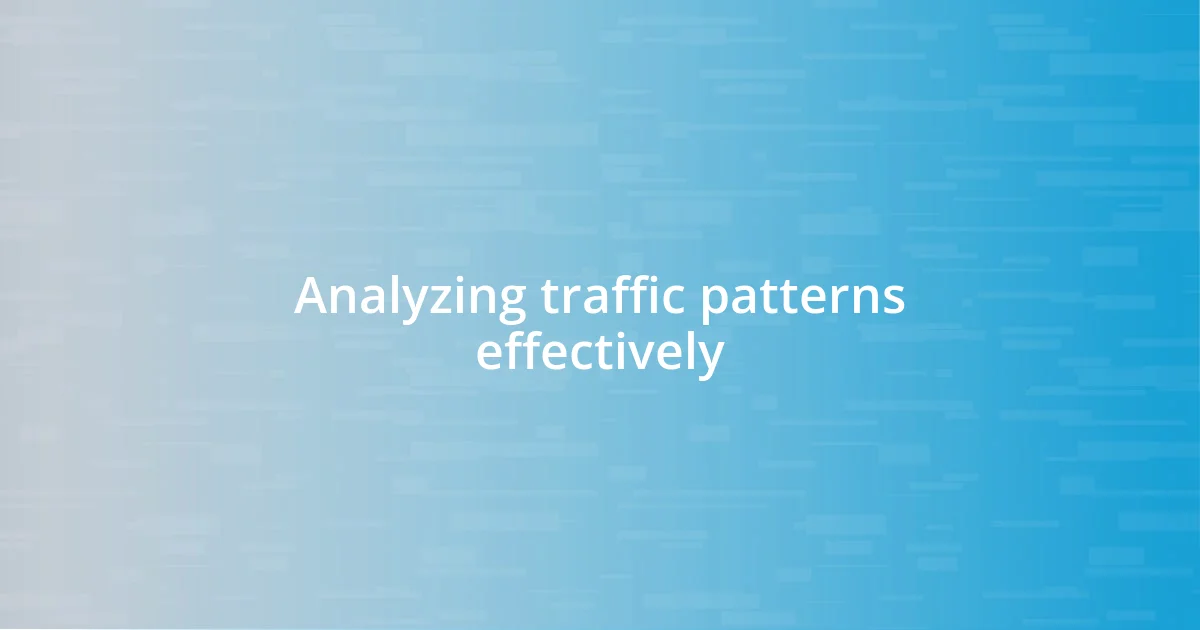
Analyzing traffic patterns effectively
When I set out to analyze traffic patterns, I found it essential to observe not just the numbers, but also the stories behind them. For instance, I once tracked my local highway during a major holiday weekend. The stark contrast in traffic volume compared to a regular weekday was eye-opening. It made me wonder how often we overlook such patterns in our daily lives—understanding them could make our commutes so much smoother.
As I delved deeper into this analysis, I realized that recognizing peak times and traffic flow trends significantly impacted my decisions. I began to adjust my travel routines, opting for early morning drives instead of rushing during the evening peak. This change was not just about saving time; I felt a sense of calmness wash over me, knowing I was outsmarting the gridlock. Have you ever experienced that relief when you finally escape the stress of heavy traffic? It’s a subtle victory that I value deeply.
Moreover, I started to appreciate the connection between traffic behavior and broader community dynamics. Observing how certain events, like local festivals or school schedules, influenced traffic helped me empathize with others on the road. It led me to rethink my own journey. Instead of just getting to my destination, I now find joy in understanding and harmonizing with the ebb and flow of my surroundings. Engaging with traffic patterns this way has truly enriched my driving experience, transforming routine commutes into moments of mindful reflection.
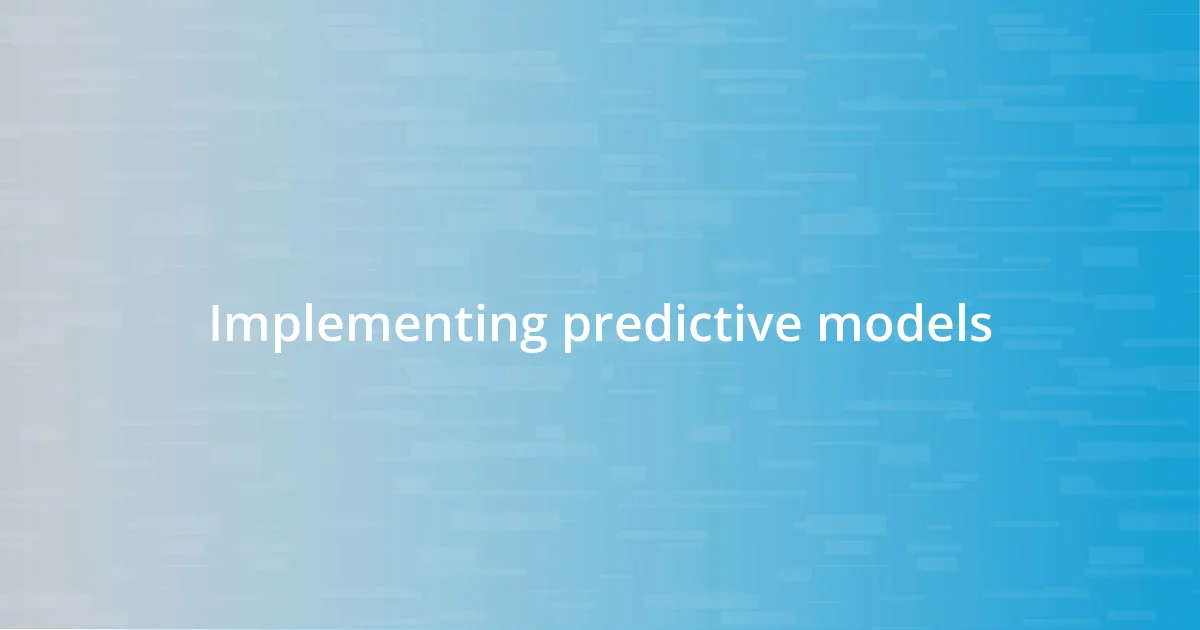
Implementing predictive models
Implementing predictive models was a game changer for me. When I first started using these models, I never anticipated how significantly they would shape my commute. I remember sitting in front of my computer, tweaking variables and inputting data, and suddenly seeing a clearer picture emerge of traffic flow patterns. That moment hit me—predictive modeling isn’t just about numbers; it’s about anticipating needs and behaviors, almost like having a sixth sense when planning my routes.
As I experimented with different algorithms, I noticed subtle shifts in their recommendations. For instance, one model highlighted evening traffic getting dense around a popular restaurant district. Initially, I dismissed it, thinking my route was safe, but I chose to listen. What struck me was just how accurate that model turned out to be. It saved me from a frustrating detour one Friday night when I was meeting friends. Reflecting on that experience, it became clear to me that predictive models are not just tools. They can serve as valuable companions that guide us through the chaos of our often unpredictable daily lives.
Another aspect that amazed me was how adjusting parameters could influence outcomes. By changing the time of day or the day of the week in the model, I could see how rush hour truly affects different corridors. Have you ever considered the impact of a simple tweak in timing? For me, it felt empowering. I began to harness this capability to better plan my errands—what once felt like haphazard driving became a strategic endeavor, making me feel more in control of my time and less subject to the whims of traffic. Each predictive insight not only alleviated stress but also provided me with a sense of accomplishment in navigating my environment.
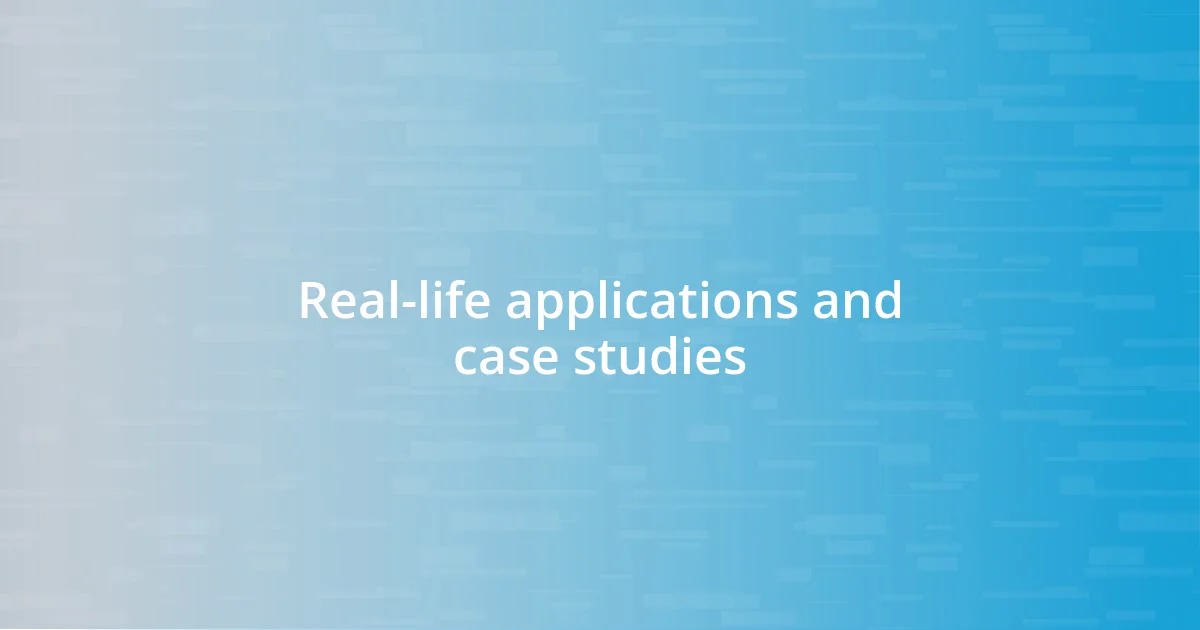
Real-life applications and case studies
One of the most striking real-life applications of predictive traffic analysis I encountered was during a community-wide event in my city. I remember volunteering to help coordinate traffic flow for a music festival. By using a simple predictive model, we could anticipate surge times based on historical data from previous years. The result? We successfully diverted traffic away from congested areas, significantly reducing delays for festival-goers. It was rewarding to witness firsthand how data-driven decisions positively impacted people’s experiences.
In another instance, I decided to integrate predictive analysis into my weekly grocery runs. I tracked traffic patterns around my local supermarket and noticed that specific days and times led to much longer waits. By predicting when the store would be busiest, I began scheduling my trips for less congested periods. It was a small change but made my routine feel almost leisurely. Have you ever found a way to simplify something mundane? That sense of discovery kept me motivated to refine my approach.
Lastly, I’ve also seen how businesses leverage predictive traffic analysis to optimize their deliveries. A friend of mine runs a local bakery that used predictive modeling to adjust their delivery schedules. By analyzing peak traffic times and adjusting their routes accordingly, they not only improved delivery times but also managed to cut fuel costs. That kind of efficiency strikes me as crucial in today’s fast-paced world—don’t you think? Witnessing these practical examples reminded me that predictive analysis isn’t just a technicality; it’s a vital tool that can enhance everyday life in remarkable ways.
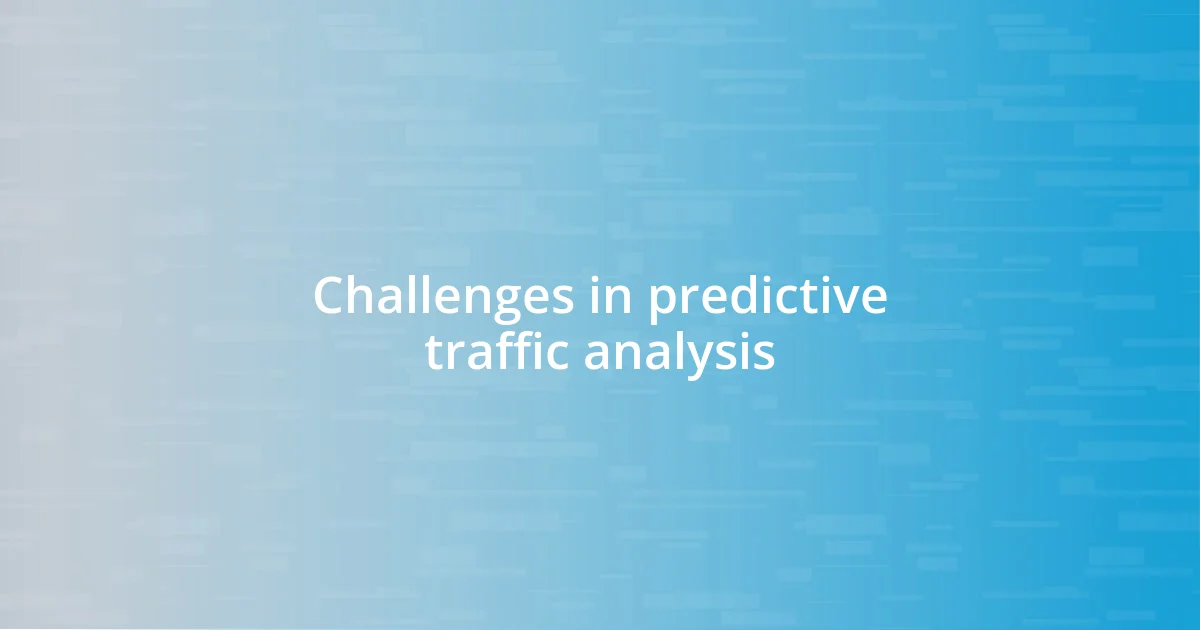
Challenges in predictive traffic analysis
Navigating the landscape of predictive traffic analysis isn’t always smooth sailing. I encountered multiple hurdles that challenged my understanding and implementation of these models. One major issue was the variability of traffic patterns. It was surprising how often unexpected events, like road construction or accidents, disrupted even the most reliable predictions. These disruptions made me wonder: how much can we really rely on data when the real world is so unpredictable?
Another challenge I faced was data quality. While working with historical datasets, I learned that inaccuracies could significantly skew predictions. I can recall a frustrating moment when I realized that outdated information led me to believe a route was clear when it was anything but. This experience taught me the importance of using up-to-date and precise data. It raised a question in my mind: have you ever considered how the quality of information impacts our decision-making?
Lastly, integrating predictive models with real-time data presented its own set of complexities. When trying to merge data from different sources, I encountered compatibility issues that made the process cumbersome. It was a steep learning curve, but I started to appreciate how critical it is to have cohesive systems. I often ask myself, how can we enhance our predictive capabilities if our data streams aren’t seamless? Discovering this interconnectedness made me more determined to overcome these obstacles and create an effective traffic analysis approach.




